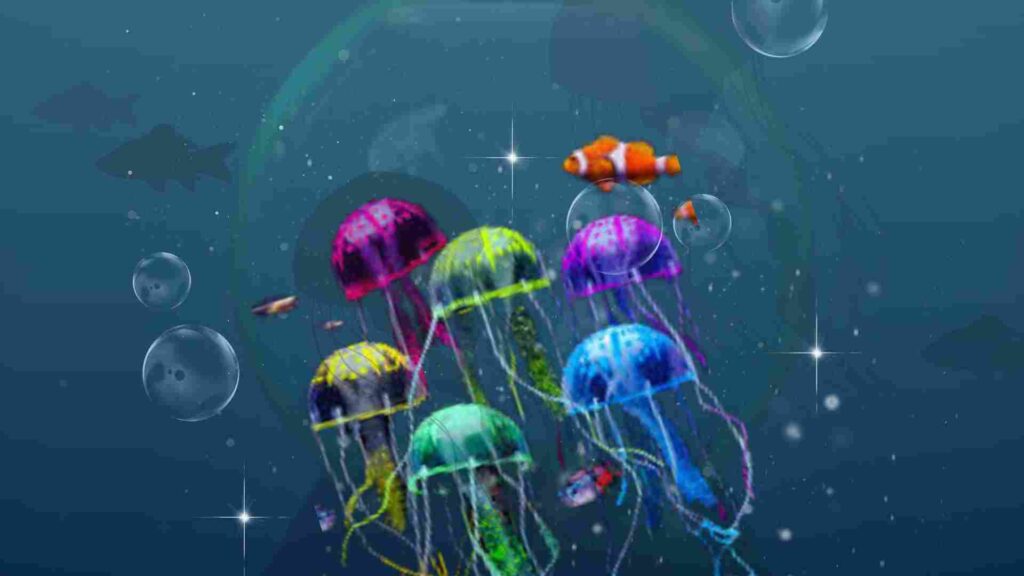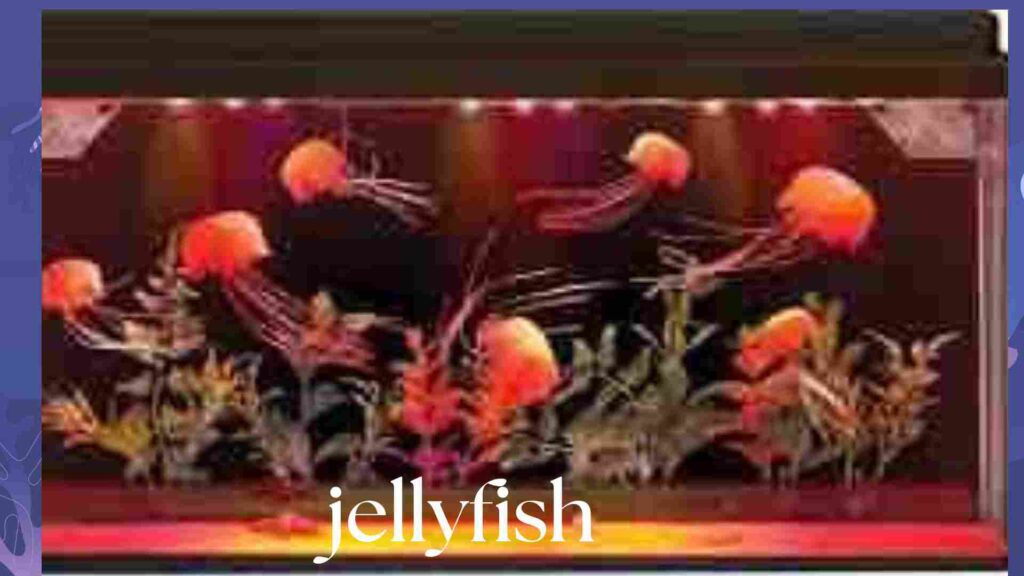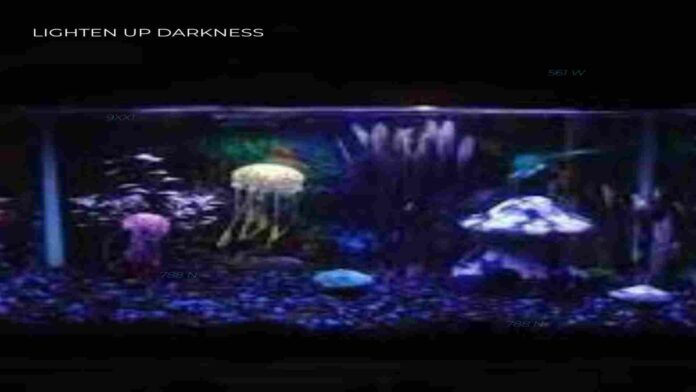Jellyfish as Pets A new craze that has caught on is keeping jellyfish in aquariums at home. Jellyfish are considered by many to be a weird pet; however, some people find them quite fascinating. Rather than selling or giving them away, most people who keep jellyfish as pets let their pet jellyfish die. Thus, while it is very easy to buy jellyfish online, the effort of caring for them will force many people to abandon this venture altogether.
In this article, we look at the possibility of having jellyfish as ‘pets’, from the kind of species and their tank to their upkeep and upkeep expenses. Sounds nice, right? Are jellyfishes the best option for you? Let’s go into the specifics.
Why Keep Jellyfish as Pets?
Jellyfish are one of the most spectacular wonders of nature with fascinating beauty in their poise and movements swaying gently in water, almost cloudlike. The way they float through the water is such an artistic display and captivating that it is fair to consider them as art pieces. The possession of jellyfish allows one to import this exquisite beauty to one’s house, which can convert any place into a relaxing one.
The other distinguishing aspect which is very similar to the nature of people is the difference of jelly fish with the other pet animals. Fish, dog, cat and all the household animals which people normally tame do not draw so much attention jellyfish do and they entice one’s imagination. Their presence is a great icebreaker which rather suits people who are fond of anything out of the ordinary or the rare.
Quite apart from their aesthetics and uniqueness, jellyfish can have a practical purpose. Studies also show that gazing upon and essentially caressing one of these gentle creatures in its tranquil movements helps alleviate stress and induces relaxation; therefore they are just apt for soothing space designs. Xen11, jellyfish aquariums not only enhances the beauty of the belongings in the home office or the living room or even the bedroom but also creates a sense of balance and harmony within the self. If you are searching for a pet that is beautiful to look at and also adds tranquility to surrounding, then jellyfish are the most suitable.
Types of Jellyfish Suitable for Home Aquariums:

It is necessary to know that some jellyfish species are more suitable to take care of in an aquarium than others due to their adaptability or hardiness. For instance, the Moon Jellyfish is recommended because of its beautiful round dome shape and graceful motions, and the Blubber Jellyfish is recommended because of its vibrant colors and robust shape. All these species can be categorized as easy to maintain in aquariums, as they possess other features which allow them to do well in aquariums designed for such purposes.
For instance, they can easily survive in an aquarium for a long time since they are kept captive. They also do not require much effort in keeping them because they only eat brine shrimps or planktons. However, it should be made clear that keeping jellyfish in home aquariums require as much effort as keeping any pet because jellyfish are very delicate creatures that require specific types of tanks more or less like Kreisel tanks that discourage the occurrence of injuries by making sure that the water flows smoothly around the jellyfish and the edges of the tank are not sharp.
In addition to that, it is necessary to take caution and look at the relevant legal stipulations with regards to keeping jellyfish before any meaningful commitment is made. In some regions, particular groups of jellyfish might be restricted due to the potential environmental effects or for the purpose of managing alien species. It is always advisable to check that whether particular species of jellyfish which someone wishes to purchase is not banned in their home country to prevent law enforcement and environmental issues.
Special Requirements for a Jellyfish Aquarium:
Tank Design:
To keep jellyfish, one needs a special tank and the best option in the market is known as Kreisel tanks. Various features make Kreisel tanks fish tanks but instead designed for keeping jellyfishes. For instance, the bottom part of the tank may be made in circular or semi circular shape with the water entering and being circulated round in a gentle manner to enable the jellies to go along with the water currents. The design encourages the movement of jellyfish and allows them to swim naturally as they would do in the ocean. Additionally, the gentle water flow also eliminates the chances of jellyfishes being caught in corners and filters as is usually the case in normal tanks.
Water Quality:
Normal tanks cannot keep jelly fish since these sort of organisms are very soft and weak. Typical aquarium systems have features that are likely to injure jellyfish; for example, these include sharp corners, robust flows, or open strainers. These organisms are soft and have no armor in the form of bones or shells and therefore, it is easy to get injured when harshly pressed against walls of the tank or worse, when sucked into a filter. Soft bodied organisms such as jelly’s cannot swim in just any type of tank since they need suitable and constant water currents to move about. Most standard tanks do not provide such water currents.
Besides being beneficial for the welfare of your jellyfishes, a Kreisel tank will also ensure that your jellyfishes remain beautiful and hence you will be able appreciate their beauty fully without harming them in any way.

Types of Jellyfish Suitable for Home Aquariums
Building a suitable environment for the jellyfish aquarium proves to be quite a chore as factors like salinity, acidity, and temperature directly affect the health status of the jellyfish. Typically, jellies would prefer to dwell in waters whose conditions bare some similarities to that of the ocean where the salt content is around thirty to thirty-five ppt. It is necessary to sustain this equilibrium so as not to over stress them as either very high or very low pressure might cause them distress and in some cases death. Just Like this, a perfect range of 8.0 – 8.4 should also be established as very high or very low ph values will destroy their cells. Water temperature is another nonnegotiable factor that specifies its average requirements for most species to be in the range of 18 – 24 degrees Celsius (64 – 75 degrees Fahrenheit). Water temperature shock is detrimental to jelly-fishes’ health as very low or very high water temperatures can be a health hazard to them.
In order to keep these ideal water conditions, a dependable filtration system is needed. Unlike regular aquariums, although this is a large tank for jellyfish, very low turbulence filtration has to be used to avoid harming the jellyfish. The filters must enable the circulation of water in the tank without creating a motion that will buoy the jellyfish up against the edges of the tank or the tank’s walls. They should also filter out waste and excess food from the water in order to keep it clean and prevent the growth of harmful microbes or ammonia for example. To encourage safety for the jelly fish it is always advisable to do water bilge checks often and water cleaning processes to ensure these conditions are adhered to and help keep a healthy environment for your jellyfish.
Lighting and Flow:
In the case of a jellyfish aquarium, the soft LED light and gentle water movement are added not only for the health of the jellyfish but also for the enhancement of their beauty.
Soft LED illumination is a secure and aesthetically pleasing way to light the tank. Hard lighting increases the stress levels of jellyfish and their natural behavior is disturbed. Soft LEDs however, are made to simulate the dim light which is found underwater. Furthermore, LED lights come in colors, which makes it possible to design an aquarium that highlights the jellyfish’s clear shells and their exquisite motions. Also, with personalized lighting, the tank can be used as a soothing piece of decor in the house or office.
Gently flowing water instead is equally significant since it imitates the ocean currents that jellyfish use for mobility and feed. Kreisel tanks are made such that gentle circular movements are granted to jellyfishes preventing them from being settled or trapped at the edges. Such controlled motion aids in their comfort and protection and decreases the probability of injury to their frail parts. Thus, soft LED lighting and controlled water movement in such aquariums serve the purpose of not only maintaining the health status of the jelly fish but also provide a pleasant zen like atmosphere to the user.
Care and Feeding of Jellyfish:
Diet: Available Foods for Jellyfish

Jellyfish are opportunistic predators and eat anything from brine shrimps, planktons, and jellyfish formulated feeds. These curves tend to be very small in size and are the building blocks which jellyfish depend on when kept in captivity. Some jellyfish keepers also give jellyfish frozen baby brine shrimps or even live ones which are less hard to find and bring their natural feeding pattern more closely.
Feeding Frequency and Methods
Feeding jellyfish is simple but a necessary activity. Most jellyfish are fed one or two times a day with the frequency determinants resting on the size and the type of jellyfish. This is because any uneaten food will cause the water conditions to deteriorate very fast and so overfeeding should be avoided. A good way to feed them is to put the food in the water column and let the jellyfish grab it as it swims around with its tentacles. A feeding pipette or dropper can be used in such a way that feeding is done without much loss of food.
Monitoring Health: Signs of Stress or Poor Water Conditions.
It is imperative to constantly observe the behavior and appearance of your jellyfish to keep them healthy. So as to avoid them from experiencing any stress due to the water conditions or any other factors, the following signs can be monitored;
It refers to the loss or stunting of the body size which in most cases results from protein energy malnutrition or extreme underfeeding.
This refers to water enhancements that have particles suspended within it or has color changes that are usually associated with a higher concentration of particles leading to waste overload.
This or these movements are not very fluid and appear ragged and abnormal which may signify the water current or temperature or salinity levels are at an unfavorable state.
This is the shortening or the absence of the coloration which indicates bleaching and also signifies a state of stress or starvation.
In order to prevent these issues from escalating, regular water monitoring and salinity, pH and temperature corrections before the corrections are of utmost importance. When healthy, jellyfish will exhibit a rhythmic smooth pulse motion, retaining clarity and brightness in their body.
Challenges of Keeping Jellyfish:
Heavy Upfront Investments for Equipment
However, there is a high initial cost for specialized appliances to keep jellyfish. Kreisel tanks which are designed for jellyfishes rearing are expensive than ordinary fish tanks because of their rounded edges and controlled flow of water features among others. Other expenses include the aquarium high-grade water filtration system, water pumps, LED lamps, and maintenance devices like salinity and PH meters. This can serve as a deterrent for many potential jellyfish keepers.
Delicateness, and Sensitivity to the Water Condition
Jellyfish are very intricate animal and their presence is very dependent on specific water parameters. Any of these factors like salinity, pH or, even temperature may prove to be overstressful and detrimental in no time. Unlike other animals that are more resilient like pets, jellyfish do not have ways of coping with abrupt changes hence constant checking and upkeep is critical. Even the tiniest of mistakes, such as an unwashed filter or a small change in water temperature, can prove fatal.
Short Lifespan as Compared to Other Pets
One of the main problems associated with having jellyfish as pets is the lifespan of a jellyfish. The majority of the species tend to have a lifespan of about 6 to 12 months in captivity, though there are individuals that can live for more than a year if they receive utmost care. This can be a discouraging factor for someone looking forward to a long term of pet friendship.
Periodic Maintenance and Water Exchange
More so, the aspect of jellyfish tank maintenance is never ending. To sustain a healthy environment devoid of toxic ammonia and nitrates, the water should be changed weekly or biweekly. Filter maintenance is also necessary, and salinity and ph levels need to be monitored periodically to ensure they are within the acceptable limits. While it is true that jellyfish do not need active attention every day like any other animal, the observation of their environment still calls for some level of hard work and concentration.
These difficulties notwithstanding, the graceful jellyfish are visually pleasing and meditative, hence worth the trouble for those who can endure.
Alternatives to Keeping Jellyfish:
Aquariums and LED Jellyfish Tanks As Affordable Alternatives
Do you want to keep jellyfish but finding the maintenance or cost hard? Fret Not, there are virtual forms and LED jellyfish tanks that do not require any commitments and one can enjoy their beauty. An LED jellyfish tank is a decorative aquarium imitating the motion of real jellyfish by colorful and animated replicas of jellyfishes together with active water and a soft colored changing lights. Such tanks do not require feeding, cleaning or any special gadgets hence they are very cheap and easy for anyone who loves jellyfishes.
For even more details, computers or smart TVs can include external displays, which allow viewers to experience a breathtaking, three-dimensional, high-resolution image of jellyfish swimming in a virtual ocean. When focused on software for iphones, app or screensaver will allow for jellyfish in motion and calming background for the house without the house occupants having to keep a tank.
Going to the Local Aquarium to Look at Jellyfish and Not Have any Exotic Pets
Going to public aquariums is perhaps the best way to view jellyfish which are kept in ornamental display tanks. This way, you get to appreciate these amazing ocean creatures in actions in not just displays, but also in exhibitions that showcase every jellyfish’s prolonged and gentile existence nearly in perfect lighting and under expert care. This is beneficial for those suffering jellyfish love but can’t afford to keep them.
Learning about jellyfish behavioral patterns, different types, and varieties, and the ecological zone in which they inhabit is extremely useful. No doubt, this is rather a win-win scenario; you get to view jellyfish and contribute to protecting the environment.
Is Keeping Jellyfish Right for You?
Evaluating Your Schedule, Finances and Enthusiasm for Keeping Responsive Patrons
It is always a good idea to think about things like schedule, budget, and commitment whenever you are considering purchasing jellyfish. Jellyfish need special tanks, specific water conditions, and also regular activities such as feeding and checking water parameters. Therefore, if you are fond of maintaining aquarium and have all the means to take care of them, this species of jellyfish as a pet will not disappoint you.
Considering Advantages and Disadvantages of Maintaining Jellyfish as Domesticated Animals
Jellyfish are beautiful and also do not need much from a person which makes them perfect to keep for viewing purposes. These however have low buying prices but delicate nature and short lifespan. The above considerations will make it easier for you to determine if they are suitable pets for you or not.
Conclusion:
Keeping jellyfish, besides its beauty and peace, brings certain difficulties such as exorbitant expenses and a need for tender care. Proper investigation is crucial to guarantee that you are ready for the obligation. For the ardent hobbyist, jellyfishes can become interesting yet demanding pets, adding soothing refreshing essence to any place.
